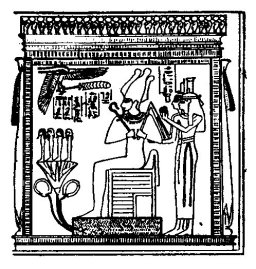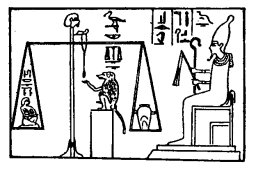
Masonic, Occult and Esoteric Online Library
The Egyptian Book of the Dead
By E. A. Wallis Budge
Plate IV
Vignette: Ani, found just, is led into the presence of Osiris. On the left the hawk-headed god Horus, the son of Isis, wearing the double crown of the North and the South, takes Ani by the hand and leads him forward towards "Osiris, the lord of eternity" Ausar neb t'etta, who is enthroned on the right within a shrine in the form of a funereal chest. The god wears the atef crown with plumes; a menat (see p. 245, note 2) hangs from the back of his neck; and he holds in his hands the crook, sceptre, and flail, emblems of sovereignty and dominion. He is wrapped in bandages ornamented with scale work. The side of his throne is painted to resemble the doors of the tomb. Behind him stand Nephthys on his right hand and Isis on his left. Facing him, and standing on a lotus flower, are the four "children of Horus (or Osiris)," or gods of the cardinal points. The first, Mestha, has the head of a man; the second, Hapi, the head of an ape; the third, Tuamautef, the head of a jackal; and the fourth, Qebhsennuf, the head of a hawk. Suspended near the lotus is an object which is usually called a panther's skin,[1] but is more probably a bullock's hide.
The roof of the shrine is supported on pillars with lotus capitals, and is surmounted by a figure of Horus-Sept or Horus-Seker and rows of uræi.
In the centre Ani kneels before the god upon a reed mat, raising his right hand in adoration, and holding in his left hand the kherp sceptre. He wears a whitened wig surmounted by a "cone," the signification of which is unknown. Round his neck is a deep collar of precious stones. Near him stands a table of offerings of meat, fruit, flowers, etc., and in the compartments above are a number of vessels for wine, beer, oil, wax, etc., together with bread, cakes, ducks, a wreath, and single flowers.
[1. On the bullock's hide, in which the deceased, or the person who represented him, was supposed to wrap himself, see Virey, Tombeau de Rekhmara, p. 50, and plate 26, lower register.]
Appendix: The shrine is in some instances represented in the shape of a pylon, the cornice of which is ornamented either with uræi, or with the disk of the sun and feathers, emblematic of Maat. It usually rests upon a base made in the shape of a cubit, The throne upon which Osiris sits is placed upon reed mats (British Museum papyrus No. 10,471), or upon the cubit-shaped base, or in a pool of water, from which springs a lotus flower with buds and having the four gods of the cardinal points (see British Museum papyrus No. 9901) standing upon it. In some of the

oldest papyri the body of Osiris is painted white, and he stands upright. Isis is described as "great lady, divine mother," and Nephthys as "the mistress of the underworld." In British Museum papyrus No. 10471 the scene of the presentation of the deceased to Osiris is unusual and of interest. On the right the scribe Nekht and his wife Thuau stand with both hands raised in adoration of Osiris. Behind them, upon a cubit-shaped base, is a house with four windows in its upper half, and upon the roof two triangular projections similar to those which admit air into modern houses in the East. Before the door are a sycamore (?) tree and a palm tree, with clusters of fruit; on the left is the god Osiris on his throne, and behind him stands "Maat, mistress of the two countries, daughter of Ra," above whom are two outstretched female arms proceeding from a mountain and holding a disk between the hands. In the centre, between Osiris and the deceased, is a pool of water with three sycamore (?) trees on each side, and at each corner a palm tree bearing clusters of dates; and from it there springs a vine laden with bunches of grapes.
In British Museum papyrus No. 10,472 the god seated in the shrine wears the crown of the god Tanen, and is called "Ptah-Seker-Ausar, within the hidden place, great god, lord of Ta-sert, king of eternity, prince of the everlasting."
Text: Saith Horus, the son of Isis: "I have come unto thee, O Unnefer, and I have brought the Osiris Ani unto thee. His heart is [found] righteous coming forth from the balance, and it hath not sinned against god or goddess. Thoth hath weighed it according to the decree uttered unto him by the company {p. 261} of the gods; and it is very true and righteous. Grant him cakes and ale; and let him enter into the presence of Osiris; and may he be like unto the followers of Horus for ever."
Behold, Osiris Ani saith: "O Lord of Amentet (the underworld), I am in thy presence. There is no sin in me, I have not lied wittingly, nor have I done aught with a false heart. Grant that I may be like unto those favoured ones who are round about thee, and that I may be an Osiris, greatly favoured of the beautiful god and beloved of the lord of the world, [I] the royal scribe indeed, who loveth him Ani, triumphant before the god Osiris."
Appendix: The usual title of this chapter [XXXB.] is, "Chapter of not allowing the heart of [the deceased] to be driven away from him in the underworld."[1] it is an address by the deceased to his own heart, which he calls his ka or "double" within his body. It should be accompanied by a vignette of the trial of the heart in which the heart is weighed against the dead man himself, as in the ancient Nebseni papyrus.

In the Ani papyrus, however, it will be observed that the heart is being weighed against the feather of the Law, Maat, a scene which often accompanies Chapter CXXV.
Interesting variants of the vignettes of Chapter XXXB. are given by Naville (Todtenbuch, Bd. I., Bl. 43), where we find the deceased addressing either his heart placed on a stand, or a beetle, or a heart to which are attached the antennæ of a beetle. In certain papyri this chapter is followed by a rubric:--"[This chapter is] to be said over a scarab[2] of green stone encircled with smu metal, and [having] a ring of silver, which is to be placed upon the neck of the dead. This chapter was found in Khemennu.[3]
[1. ###
2. Chapter XXXA. is never found inscribed upon scarabs.
3. I.e., Hermopolis Magna, the metropolis of Un, the 15th nome of Upper Egypt, the city
called ### by the Copts, and Eshmûnên, ### by the Arabs. It was the abode of the "eight" (xemennu) great primeval gods, and of Thoth, the scribe of the gods. (See Meyer and Dümichen, Geschichte des alten Agyptens, p. 185.)]
written upon a slab of steel of the South, in the writing of the god himself, under the feet of the majesty of the god, in the time of the majesty of Men-kau-Ra,[1] the king of the North and of the South, triumphant, by the royal son Heru-tata-f[2] who found it while he was journeying to inspect the temples."[3]
The scarabs which are found in the mummies, or lying upon the breast just above the position of the heart, form an interesting section of every large Egyptian collection. In the British Museum series every important type of the funereal scarab is represented. They are made of green basalt, green granite (Nos. 7894 and 15,497), white limestone (Nos. 7917, 7927, 15,508), light green marble (No. 7905), black stone (Nos. 7907, 7909, 7913), blue paste (Nos. 7904, 14,549), blue glass (No. 22,872), and purple, blue, or green glazed faïence (Nos. 7868, 7869). They vary in size from 5 inches to 2 inches in length. On the hard stone examples the text of the Chapter of the Heart, more or less complete, is usually cut on the base in outline; but it is sometimes traced in red ink (No. 7915), or in gold (No. 15,518). Incuse hieroglyphics are sometimes filled with gold (No. 7881). The name of the person with whom the scarab was buried usually precedes the text of the Chapter of the Heart; but in many instances blank spaces are found left without insertion of the name--a proof that i, these amulets were bought ready-made. The base however is often quite plan (Nos. 7965, 7966), or figures of Osiris, Isis, and Nephthys occupy the place of the usual inscription (Nos. 15,500, 15,507). The backs of scarabs are generally quite plain, but we find examples inscribed with figures of the boat of the Sun Osiris, with flail and crook the bennu bird, and the u'tat (No. 7883), Ra and Osiris (No. 15,507), and the bennu bird with the inscription neteri ab en Ra, "the mighty heart of Ra" (No. 7878). A finehard, green stone scarab of the Greek or Roman period has upon the back the figures of four Greek deities (No. 7966). In rare instances, the beetles have a human face (Nos. 7876, 15,516) or head (No. 7999). Carefully made scarabs have usually a band of gold across and down the back where the wings join: an example of the late period (No. 7977) has the whole of the back gilded. The scarab was set in a gold oval ring, at one end of which was a smaller ring for suspension from the neck or for attachment to the bandages of the mummy (No. 15,504). The green glazed faïence scarab of Thothmes III. (No. 18,190) was suspended by a gold chain from a bronze torque. A thick gold wire to fit the neck is attached to No. 24,401. The base of the scarab is sometimes in the form of a heart (Nos. 7917, 7925). A remarkable example of this variety is No. 7925, in which are
[1. The fifth king of the IVth dynasty.
2. This prince is said to have been a very learned man, whose speech was difficult to be understood (see Wiedemann, Aeg. Geschichte., p. 191).
3. For the hieroglyphic text, see pp. 13-15. This rubric was published by Birch, Aeg. Zeitschrift, p. 54; and by Rosellini, Breve Notizia interno un frammento di Papiro funebre Egizio essistente nel ducale museo di Parma; Parma, 1839, 8vo.]
the emblems of "life," "stability," and "protection," engraved on the upper part of the base. Across the back of this scarab is -- ###;[1] On the right wing:-- ### and on the left ###[2]. A highly polished, fine green basalt scarab with human face (No. 7876) is set in a gold base, upon the face and edges of which are cut part of the Chapter of the Heart. At a period subsequent to the XXIInd dynasty inscribed funereal scarabs in marble, paste, etc., were set in pylon-shaped pectorals made of Egyptian porcelain, glazed blue, green, or yellow, which were sewed to the mummy bandages over the heart. On such pectorals the boat of the Sun is either traced in colours or worked in relief, and the scarab is placed so as to appear to be carried in the boat; on the left stands Isis, and on the right Nephthys (Nos. 7857, 7864, 7866).
